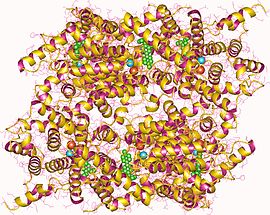Cyclic nucleotide phosphodiesterase
| 3',5'-cyclic nucleotide phosphodiesterase | |||||||||
|---|---|---|---|---|---|---|---|---|---|

Phosphodiesterase 4D hexamer, Human
|
|||||||||
| Identifiers | |||||||||
| Symbol | PDEase_I | ||||||||
| Pfam | PF00233 | ||||||||
| InterPro | IPR002073 | ||||||||
| PROSITE | PDOC00116 | ||||||||
| SCOP | 1f0j | ||||||||
| SUPERFAMILY | 1f0j | ||||||||
| CDD | cd00077 | ||||||||
|
|||||||||
| Available protein structures: | |
|---|---|
| Pfam | structures |
| PDB | RCSB PDB; PDBe; PDBj |
| PDBsum | structure summary |
| 3',5'-cyclic-nucleotide phosphodiesterase | |||||||||
|---|---|---|---|---|---|---|---|---|---|
| Identifiers | |||||||||
| EC number | 3.1.4.17 | ||||||||
| CAS number | 9040-59-9 | ||||||||
| Databases | |||||||||
| IntEnz | IntEnz view | ||||||||
| BRENDA | BRENDA entry | ||||||||
| ExPASy | NiceZyme view | ||||||||
| KEGG | KEGG entry | ||||||||
| MetaCyc | metabolic pathway | ||||||||
| PRIAM | profile | ||||||||
| PDB structures | RCSB PDB PDBe PDBsum | ||||||||
| Gene Ontology | AmiGO / QuickGO | ||||||||
|
|||||||||
| Search | |
|---|---|
| PMC | articles |
| PubMed | articles |
| NCBI | proteins |
3'5'-cyclic nucleotide phosphodiesterases (EC 3.1.4.17, cyclic 3',5'-mononucleotide phosphodiesterase, PDE, cyclic 3',5'-nucleotide phosphodiesterase, cyclic 3',5'-phosphodiesterase, 3',5'-nucleotide phosphodiesterase, 3':5'-cyclic nucleotide 5'-nucleotidohydrolase, 3',5'-cyclonucleotide phosphodiesterase, 3', 5'-cyclic nucleoside monophosphate phosphodiesterase, 3': 5'-monophosphate phosphodiesterase (cyclic CMP), cytidine 3':5'-monophosphate phosphodiesterase (cyclic CMP), cyclic 3',5-nucleotide monophosphate phosphodiesterase, nucleoside 3',5'-cyclic phosphate diesterase, nucleoside-3',5-monophosphate phosphodiesterase) are a family of phosphodiesterases. Generally, these enzymes hydrolyze some nucleoside 3',5'-cyclic phosphate to some nucleoside 5'-phosphate thus controlling the cellular levels of the cyclic second messengers and the rates of their degradation. Some examples of nucleoside 3',5'-cyclic phosphate include:
As per Andrew T. Bender and Joseph A. Beavo, there are 11 distinct phosphodiesterase families (PDE1-PDE11) with a variety in isoforms and splicing having unique three-dimensional structure, kinetic properties, modes of regulation, intracellular localization, cellular expression, and inhibitor sensitivities.
Retinal 3',5'-cGMP phosphodiesterase (PDE) is located in photoreceptor outer segments and is an important enzyme in phototransduction.
PDE in rod cells are oligomeric, made up of two heavy catalytic subunits, α (90 kDa) and β (85 kDa,) and two lighter inhibitory γ subunits (11 kDa each).
PDE in rod cells are activated by transducin. Transducin is a G protein which upon GDP/GTP exchange in the transducin α subunit catalyzed by photolyzed rhodopsin. The transducin α subunit (Tα) is released from the β and γ complex and diffuses into the cytoplasmic solution to interact and activate PDE.
There are two proposed mechanisms for the activation of PDE. The first proposes that the two inhibitory subunits are differentially bound, sequentially removable and exchangeable between the native complex PDEαβγ2 and PDEαβ. GTP-bound-Tα removes the inihibitory γ subunits one at a time from the αβ catalytic subunits. The second and more likely mechanism states that the GTP-Tα complex binds to the γ subunits but rather than dissociating from the catalytic subunits, it stays with the PDEαβ complex. Binding of the GTP-Tα complex to the PDE γ subunits likely causes a conformational shift in the PDE, allowing better access to the site of cGMP hydrolysis on PDEαβ.
...
Wikipedia
